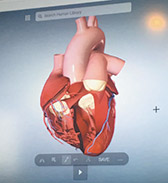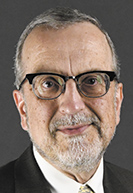Subscriber Benefit
As a subscriber you can listen to articles at work, in the car, or while you work out. Subscribe NowAt first glance it seems like something out of a science fiction movie: jurors’ eyes covered by heavy goggles, their heads swiveling from side to side as they take in a crime scene recreated for them through virtual reality technology.
Though the prospect of virtual reality as a litigation tool seems improbable now, legal tech experts predict that in coming years, VR will appear regularly in courtrooms. That time is likely still years away, they said, but predecessor technology is already popping up in court now, preparing jurors, judges and attorneys for the day when futuristic technology becomes commonplace.
 Internal view of a heart. (IL Photo/Olivia Covington)
Internal view of a heart. (IL Photo/Olivia Covington)The predicted future use of VR technology in court was included as part of the 2018 Legal Technology Predictions eBook, a report released by Indianapolis-based disaster-recovery service provider Bluelock. The report predicted that one day, VR technology could make coming into court unnecessary. Instead, witnesses and jurors will be able to analyze evidence from the comfort of their home using specialized VR headsets.
But if that day does come, it is still in the distant future, considering existing VR technology is impractical to use in court, said Tim Maher, a graphics specialist for Wolf Technical Services. Now, VR is commonly used by video game or entertainment consumers, who can put on specialized goggles that immerse them in the environment of the entertainment, making them feel as if they are part of the video game or movie.
 Maher
MaherSimilarly, the idea of using VR in court would call for attorneys or legal tech experts to recreate accidents or crime scenes so that jurors could get a full picture of the events that led to the litigation. Jurors could view the recreations through the specialized goggles, allowing them to feel as though they are at the scene of the crime.
If used effectively, those recreations could offer a higher level of accuracy and precision in accident reconstruction, said Herbert Dixon, a retired Washington, D.C. district court judge and national legal technology advocate. If investigators take photos of crash scene that accurately documented where all objects, people and evidence were located, those photos could then be stitched together using VR technology to recreate the world as the litigants saw it at the time of the incident, Dixon said.
 Ton
TonVirtual reality can be so precise as to give jurors an idea of what the weather was like at the time of an incident, said Jeff Ton, Bluelock’s executive vice president of product and service development. Or, jurors could virtually put their hands on a product that is at the core of a patent dispute, allowing them to compare the product alongside a description of the patent, all without disturbing the actual evidence, Ton said.
“There’s a lot of uses that we’ll start to see in the next year or more, but some are a little farther out,” he said.
How it’s used now
In general, Maher thinks the existing form of VR — which requires the use of multiple headsets, plus specialized computer technology and software — would be unworkable to use in today’s courts, which is why he agrees with Ton that full use of the technology is still several years away. Even so, Wolf Technical has already found ways to combine virtual reality with more commonplace legal technologies to increase the precision of crash reconstruction.
For example, 3D scanning is a tool that allows Wolf and other similar companies to make car accident recreations that can be viewed on a screen rather than through immersive virtual reality. Using a device like a land surveyor’s instruments, 3D scanners can collect physical data from a scene, such as how far apart objects are, the view from certain lines of sight, and even the lighting. That data can then be used to create 3D models or accident reconstruction animations that are highly precise.
Wolf has created such animations for numerous cases, including for the trial of former Indianapolis Metropolitan Police Department Office David Bisard, who was convicted of killing a motorcyclist while driving drunk. To create an animation of the Bisard accident, Wolf closed the road where the accident occurred and took video while driving at the same speed as Bisard. That video was then used to illustrate what Bisard’s point of view would have been as he sped down the road, and was also used to help the reconstructionists create an accurate animation.
 Nightenhelser
NightenhelserThe difference between the animations and VR is the lack of the immersive experience, said Stuart Nightenhelser, a crash reconstructionist at Wolf. For example, a juror would not be able to feel the speed of Bisard’s car simply by watching the recreation of a scene. However, the animation videos are accurate enough that once opposing counsel views them, they often choose to settle a case rather than going to trial, Maher said.
There is also software available that allows firms to access VR-like technology without hiring a company like Wolf. For example, Indianapolis personal injury firm Wilson Kehoe Winningham utilizes a program known as BioDigital 3D to interactively illustrate how specific parts of the body are affected by accidents or injuries.
In a recent case involving heart complications, partner Bruce Kehoe used BioDigital 3D to walk jurors through the different parts of the heart and show them where the damage was done. Using BioDigital features, he was able to strip away layers of the heart not necessary for his illustration, such as the fatty outer layers, and hone in on the sections of the heart that were affected. Kehoe could also write and draw on the interactive model, all using a wireless tablet he could either use himself or hand off to a witness.
What has to change
Technology such as BioDigital 3D or Wolf’s accident animations are predecessors to true immersive virtual reality, but all parties agree the technology will need to continue to advance before it becomes practical for use in court.
Cost, for example, is a major inhibitor, Dixon said. The current market lists the Oculus Rift, one of the most common VR headsets, at about $400 each.
Further, the immersive nature of VR presents significant issues with creating a consistent record, Nightenhelser said. If each juror is given a headset and is able to view the recreated scene in their own way, then it would be nearly impossible for court reporters to record each jurors’ experience or create a record that could be preserved for appeal, he said.
There are also ethical concerns to consider when using VR in court, Ton said. If a scene is not recreated exactly as it was at the time of an incident, jurors or a court will not be able to accurately consider the evidence, threatening the integrity of the trial, he said.
Similarly, pure human error could compromise a trial if a juror does not understand how to use VR technology, Nightenhelser said. Without a set of controls over how a juror utilizes the technology to examine evidence, VR will remain impractical, he said.
“The main things that will have to change are the control issues and the ability to produce a record,” Nightenhelser said.•
Please enable JavaScript to view this content.

